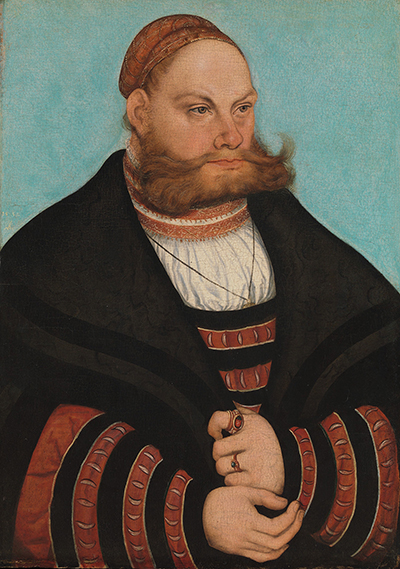Lukas Spielhausen, an oil and gold on beechwood painting, was executed by Lucas Cranach in 1532. The painting measures 50.8 x 36.5 centimetres and is located in the collection of the New York-based art museum Metropolitan Museum of Art.
The sitter in the painting is Lukas Spielhausen; he is identified by the initials JS seen on the signet ring and the dress with black and yellow stripes that the electoral court of Saxony members used to wear. By 1531, Spielhausen was a lawyer serving in the judicial curia, which was under Johann the Steadfast. When the sitting took place, Spielhausen was around 39 years old. The date of Lukas Spielhausen by Lucas Cranach is compatible with the appearance of the sitter. The interplay of curves seen in the costume and the lively pattern colours together with the contrast between Spielhausen's tightly bundled hair as well as his projecting beard and moustache give the portrait a remarkable visual impact.
The sitter's gold-embroidered cap, rings, and collar display paint buildup, colour combination and the skilful handling characteristic of the artist's work. Cranach proceeded systematically, beginning with the middle tones, then applying the darks. He then followed with the final highlights. The passages were further decorated with mordant gilding. In the sitter's collar, the artist used a double-pointed brush to make parallel strokes of pale yellow. The hands and facial features were done in a liquid medium, which was applied with a brush.
The panel support of the painting is made of 2 beech boards and the grain is oriented horizontally. The boards came from the tree that Cranach derived the boards that he used for Melanchthon portrait. The panel has been reinforced in the middle of the verso and the tow employed in a horizontal band. On the verso, adz marks are visible and there is a 3.8 cm-shallow bevel on all sides. Wood blocks affixed to the verso were used to reinforce the central join in a past treatment. Additional blocks were also attached to the bottom and the top of the panel. Opaque brown paint was used to coat the entire reverse, including the blocks. The verso also has pieces of an earlier stabilising treatment which involved 3 cross-grained battens that are symmetrically arranged. The artist prepared the panel with priming containing lead white and white ground. The diffuse vertical banding is connected with the preparation layers.




